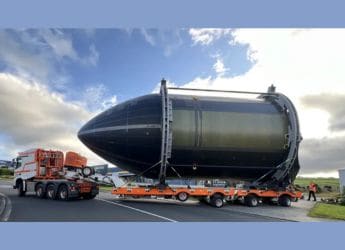- Home
- Science
- Science News
- JWST Finds Black Hole Between Galaxy Cores, Hinting at Rare Direct Collapse Birth
JWST Finds Black Hole Between Galaxy Cores, Hinting at Rare Direct Collapse Birth
A newly detected black hole may be the first observational proof of the direct collapse formation theory.

Photo Credit: NASA, ESA, CSA, STScI, VLA, P. van Dokkum (Yale University)
JWST reveals a rare black hole between merging galaxy nuclei, possibly born in a gas cloud
Astronomers have detected a weird black hole that is causing its galactic host to wobble like a top in the throes of “direct collapse” in the earliest phase of creation in the universe. The unique thing about this object is where it is located: between a pair of colliding galaxies, not in the nucleus of either one. That bizarre orientation suggests that instead of forming from a dying star's wreckage, the black hole might have formed from a collapsing cloud of gas and dust — something researchers had long suspected was possible but nobody had ever seen.
JWST Uncovers Rare Black Hole Between Merging Galaxies, Backing Direct Collapse Theory
As per the Yale-led COSMOS-Web survey team, the Infinity Galaxy was created through a head-on merger of two disk galaxies. Lead researcher Pieter van Dokkum explained that the black hole's location was the biggest surprise. Instead of being housed in either galactic nucleus, it sits between them, aligning with the velocity of the surrounding ionised hydrogen gas. The black hole is actually so strangely positioned and moving so quickly in relation to its host galaxy that it might even have been formed in its current spot, supporting the “heavy seed” idea.
The JWST find indicates supermassive black holes existed even 500 million years after the Big Bang, something previously believed only possible through the strong compression of gas around galaxies.
Alternative explanations, including a runaway black hole or one from a third, unseen galaxy, were ruled out by the researchers. Preliminary measurements show the black hole's velocity matches that of the surrounding gas, strengthening the direct collapse hypothesis. X-ray data from NASA's Chandra and radio signals from the Very Large Array also confirm that the black hole is actively feeding.
Though not definitive, this finding represents some of the strongest observational evidence for direct collapse so far. “This is really something we have not seen before,” Van Dokkum mentioned, adding that both galaxy nuclei also house active supermassive black holes, which would make it a unique triple-black-hole system and a tantalising object for further research.
Get your daily dose of tech news, reviews, and insights, in under 80 characters on Gadgets 360 Turbo. Connect with fellow tech lovers on our Forum. Follow us on X, Facebook, WhatsApp, Threads and Google News for instant updates. Catch all the action on our YouTube channel.
Related Stories
- Samsung Galaxy Unpacked 2025
- ChatGPT
- Redmi Note 14 Pro+
- iPhone 16
- Apple Vision Pro
- Oneplus 12
- OnePlus Nord CE 3 Lite 5G
- iPhone 13
- Xiaomi 14 Pro
- Oppo Find N3
- Tecno Spark Go (2023)
- Realme V30
- Best Phones Under 25000
- Samsung Galaxy S24 Series
- Cryptocurrency
- iQoo 12
- Samsung Galaxy S24 Ultra
- Giottus
- Samsung Galaxy Z Flip 5
- Apple 'Scary Fast'
- Housefull 5
- GoPro Hero 12 Black Review
- Invincible Season 2
- JioGlass
- HD Ready TV
- Laptop Under 50000
- Smartwatch Under 10000
- Latest Mobile Phones
- Compare Phones
- Redmi Note 15 5G
- Redmi Note 15 Pro 5G
- Redmi Note 15 Pro+ 5G
- Lava Play Max
- Poco C85 5G
- Honor Magic 8 Lite
- Jolla Phone
- Realme P4x 5G
- Asus ProArt P16
- MacBook Pro 14-inch (M5, 2025)
- OnePlus Pad Go 2
- Poco Pad M1
- Just Corseca Skywatch Pro
- Honor Watch X5
- Acerpure Nitro Z Series 100-inch QLED TV
- Samsung 43 Inch LED Ultra HD (4K) Smart TV (UA43UE81AFULXL)
- Asus ROG Ally
- Nintendo Switch Lite
- Haier 1.6 Ton 5 Star Inverter Split AC (HSU19G-MZAID5BN-INV)
- Haier 1.6 Ton 5 Star Inverter Split AC (HSU19G-MZAIM5BN-INV)

















